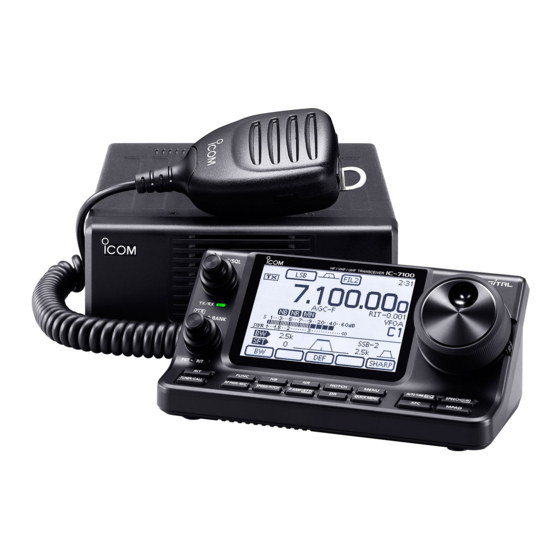
Icom IC-7100 Quick Start Manual
Hide thumbs
Also See for IC-7100:
- Advanced instructions (375 pages) ,
- Service manual addendum (294 pages) ,
- Instruction manual (197 pages)
Advertisement
Quick Links
Quick-Start Guide
for the IC-7100
prepared by KN3U
Version 5.1
4/4/2019
Figure 1
A. On/Off/Volume/Squelch
The knob at the top left of the front panel ( in Figure 1) is the volume control. Press it
to turn the radio on. Press and hold to turn the radio off.
The ring around the volume control knob ( in Figure 1) serves as the squelch control on
2 m / 70 cm FM, and as the RF gain control on HF and 6 m. The manual describes a
number of special functions that this control can perform based on menu settings. To
avoid confusion, it would be best to stick with the default behavior. For a radio that must
be used by a number of different operators, it's really important to keep things simple and
consistent.
1
Advertisement

Summary of Contents for Icom IC-7100
- Page 1 Quick-Start Guide for the IC-7100 prepared by KN3U Version 5.1 4/4/2019 Figure 1 A. On/Off/Volume/Squelch The knob at the top left of the front panel ( in Figure 1) is the volume control. Press it to turn the radio on. Press and hold to turn the radio off.
- Page 2 Figure 2 B. Menu Selection The first thing to understand about the radio is that it has a touch screen. There are five soft keys (virtual buttons) across the bottom of the screen, providing access to a menu of special functions. The functions of the soft keys change depending on which menu or sub-menu you are in.
- Page 3 C. Frequency Selection Note the primary frequency display in Figure 2. The frequency is displayed down to a resolution of 1 Hz. (There is a menu option to hide the least significant digit and only display frequency to the nearest 10 Hz.) If the frequency can’t be changed.
- Page 4 D. Operating Mode The current mode of operation (FM, LSB, USB, etc.) is displayed at the top edge of the screen. Touch the mode indicator to access a popup screen to change the operating mode. On the popup screen, there are a number of soft keys for selecting the various modes. •...
- Page 5 E. VFOs and Memories; Repeater Operations The radio has two VFOs, labeled A and B. In addition, there are 495 “regular” memories plus a handful of special memories. The memories are organized in five banks of 99 memories each, called Bank A through Bank E. So the numbering scheme for memories is as follows: A00 ~ A99, B00 ~ B99, etc.
- Page 6 button, located below the tuning dial. This is useful for determining if you are within simplex range of another station. Preamp. The radio has both a receiver preamp and an attenuator on the HF bands from 160 through 15 m. On the 17, 10, and 6 m bands, there are two preamps to choose from. On 2 m and 70 cm, there is one preamp that can be switched in and out.
- Page 7 If you wish to assign an alphanumeric name to your memory channel, you can do this after you have programmed the VFO information into the channel. Please refer to Page 11-10 of the IC-7100 Advanced Instructions manual for details.
- Page 8 Figure 4 Several configuration parameters affect the TNC performance. These are found in the SET mode under the Connectors and Function menus. The IC-7100 User Guide is a little fuzzy on the details. By experimentation, here is what I found.
- Page 9 G. Winlink VHF Operation — Laptop Setup (Windows) We are currently operating in the BYOL (bring your own laptop) mode. We are working on having a computer set up at the hospital with the software installed and configured. Even if we are successful, you might want to have the software installed on your Windows laptop (or tablet) computer as a backup.
- Page 10 • It is very important that operating mode of the IC-7100 be set to FM-D when in packet radio mode on VHF/UHF. If the received packet signal is noisy, it might help to turn the receiver preamp (P.AMP) on. On the other hand, you need to exit the FM DATA mode when you go back to suing voice.
- Page 11 (145.75 MHz, just across the street at Hughes). Set the IC-7100’s frequency. the Winlink Express session window, the connection type should be “Direct” (in other words, we are not using digipeaters to reach the gateway since these gateways are within simplex range of the hospital).










